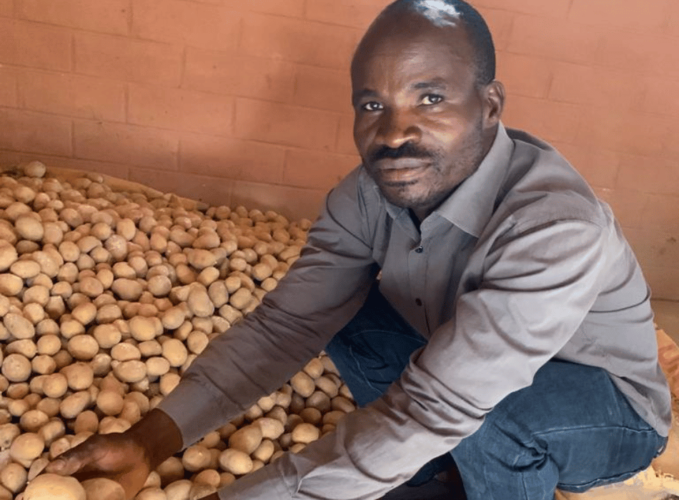Bitrus Gomas used to regularly lose nearly half his produce. The 51-year-old potato farmer lives in Pankshin Local Government Area in Plateau State in central Nigeria. He is married with four children.
Mr. Gomas is not alone. In Nigeria, up to 40 per cent of stored potato seeds are lost within the first three months of storage due to inadequate storage conditions.
Post-harvest loss (the loss of crops between harvest and consumption) is an issue for farmers, no matter the crop. In this case, loss means that the food degrades in quantity or quality to the point that it’s no longer fit for human consumption. Food loss can occur at various stages, including during processing, storage or transportation.
Mr. Gomas says his major challenges were selecting the best seed potatoes to plant and storing both the ware and seed in good condition after harvest.
However, a radio program and training from Farm Radio International and Green Innovation Centres for the Agriculture and Food Sector (GIC), funded by the German government, made a difference for Mr. Gomas.
Broadcasting radio programs to improve potato production in Nigeria
The radio program Dankali Rumbun Arziki (Potato is the hub of wealth), which aired on 90.5 FM PRTV for the past three years, was an “answered prayer” for Mr. Gomas.
The Radio Enabling Green Innovation at Scale (REGIS) project was funded by the German Federal Ministry for Economic Cooperation and Development (BMZ), and implemented by Deutsche Gesellschaft für Internationale Zusammenarbeit (GIZ) under the Green Innovation Centres for the Agriculture and Food Sector (GIC). They promoted good agricultural practices for the maize, rice, cassava and Irish potato value chains in eight Nigerian states. The radio program was a key component of the project, and the third phase ended in September 2023.
The aim with the third phase was to reach at least 7.2 million listeners. The project surpassed this target, with 10,077,000 farmers listening to at least one episode. Of those listeners, approximately 3,194,000 listened to at least seven or more of the episodes.
The listenership rate for radio programs about the potato value chain was 79.2 per cent, which means that nearly 80 per cent of people who could listen to the programs tuned in.
According to Farm Radio’s midline evaluation survey, 61.4 per cent of listeners who also had access to Green Innovation Centres program supported farming schools knew that the ideal time for harvesting potatoes is when it’s dry, compared to 47.4 per cent of GIZ-trained non-listeners.
Among farmers not trained at the farming schools, 59 per cent of listeners knew the ideal time to harvest potatoes, versus 41 per cent of non-listeners.
While those numbers are impressive, it’s the difference in individual farmers’ lives that is meaningful.
Selecting disease-free seeds and ensuring proper storage to reduce post-harvest loss of potatoes
Listening to the weekly radio program taught Mr. Gomas to first identify and select healthy plants from the farm before harvest. That way, disease-free seeds are planted for increased yield. He also learned that a good storage facility will preserve the seeds further.
Along with his friends from the Bamyash Community Listening Group, Mr. Gomas started selecting disease-free seeds and built a standard storage facility known as “diffused light storage,” which uses natural indirect light and good ventilation to encourage uniform sprouting and reduce storage losses.
Aside from using the building to store potatoes, Mr. Gomas and his friends generate income by leasing out the facility to other farmers.
Although farmers must adhere to good agronomic practices if they want to experience higher yields and income, for Mr. Gomas and his friends, post-harvest loss is now a thing of the past.

